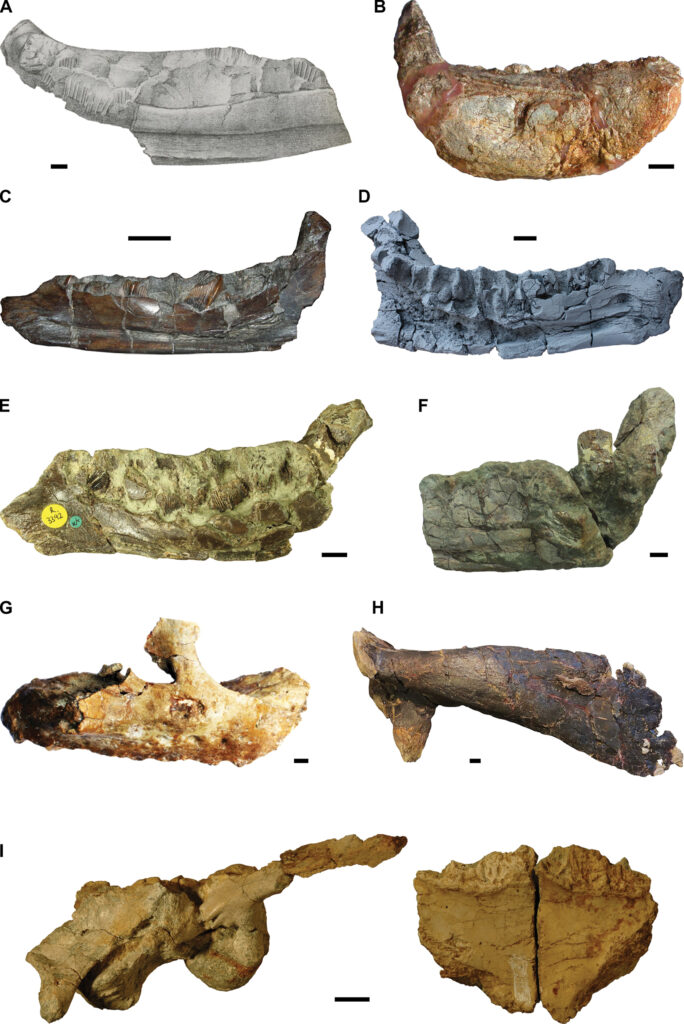@WFS,World Fossil Society, Athira, Riffin T Sajeev,Russel T Sajeev
A new study published in Fossil Record brings together intriguing details about the little-known Rhabdodontidae dinosaurs of Late Cretaceous Europe. These gregarious herbivores, characterized by robust builds and beaks specialized for tough vegetation, inhabited the European archipelago. Despite being widespread and abundant, they vanished in Western Europe due to environmental changes around 69 million years ago, while surviving longer in Eastern Europe. Their fossil record offers valuable insights into their evolution and lifestyle, although its limited nature still challenges comprehensive understanding.
When you think of dinosaurs, you might automatically imagine iconic dinosaurs as Tyrannosaurus and Triceratops. But at the same time when these were stomping on the ancient coastal plains of North America, some of their very distant cousins were reigning over Europe’s lands.
During the Late Cretaceous (between 100 and 66 million years ago), Europe was an extensive archipelago with numerous small and large islands situated in a shallow tropical sea, the so-called Late Cretaceous European Archipelago. The dinosaur groups that lived on these islands were very different from those of other continents, often being much smaller than their mainland relatives. These European dinosaurs include small and medium-sized carnivorous theropods, armoured ankylosaurs, long-necked sauropods, duck-billed hadrosaurs, and rhabdodontids.
Arguably one of the most important of these European dinosaur groups is the family Rhabdodontidae, which groups together the most common medium-sized herbivores of the Late Cretaceous European Archipelago. A joint research team from the Universities of Tübingen (Germany), Budapest (Hungary) and Bucharest (Romania) recently reviewed what we know about these peculiar dinosaurs in a new paper published in the journal Fossil Record.
Generally, rhabdodontid dinosaurs were small to medium-sized animals with an overall body length of approximately 2-6 m. “They were probably habitually bipedal herbivores, characterised by a rather stocky build, with strong hind limbs, short forelimbs, a long tail, and a comparatively large, triangular skull that tapers anteriorly and ends in a narrow snout,” explains Felix Augustin, lead author of the study in Fossil Record.
“They had a relatively robust skull with strong jaws, large teeth and a pointy beak that was covered in keratin, demonstrating that these dinosaurs were well-adapted to eating tough plants.”
In some instances, fossil remains of several individuals of different ages have been found together, indicating that they were gregarious.
Although they died out well before the mass extinction in Western Europe (about 69 million years ago), potentially due to environmental changes that affected the plants they fed on, they survived much longer in Eastern Europe and were among the last non-avian dinosaurs still present before the end of the Cretaceous (66 million years ago).
Interestingly, fossils of rhabdodontids have only been found in Europe and only in rocks ranging in age from 86-66 million years ago, so they were endemic to the Late Cretaceous European Archipelago.

Type specimens of the nine rhabdodontid species described so far. A. The original drawing of the lectotype of Rhabdodon priscus, MPLM 30, a partial left dentary. The specimen has since deteriorated (Pincemaille-Quillevere 2002). Modified after Matheron (1869). B. Holotype of Rhabdodon septimanicus, MDE D-30, an incomplete right dentary. Photo kindly provided by Eric Buffetaut. C. Lectotype of Mochlodon suessi, PIUW 2349/2, a right dentary. D. Holotype of Mochlodon vorosi, MTM V 2010.105.1, a left dentary. E. Holotype of Zalmoxes robustus, NHMUK R.3392, a right dentary. Photo kindly provided by János Magyar. F. Holotype right dentary of Zalmoxes shqiperorum, NHMUK R.4900. Note that the holotype of Z. shqiperorum also comprises several postcranial elements that presumably belong to the same individual as the dentary. Photo kindly provided by János Magyar. G. Holotype of Matheronodon provincialis, MMS/VBN-02-102, a right maxilla. Modified after Godefroit et al. (2017). H. Holotype of Pareisactus evrostos, MCD 5371, a left scapula. Modified after Párraga and Prieto-Márquez (2019). I. Holotype of Transylvanosaurus platycephalus, LPB (FGGUB) R.2070, a partial skull comprising the articulated basicranium and both frontals. Scale bars: 1 cm.
The group currently comprises nine different species from five European countries (France, Spain, Austria, Hungary, and Romania).
“The first rhabdodontid species was scientifically named more than 150 years ago and the last one as recently as November 2022, so, although the group looks back to a long research history, we still have much to learn about it,” says Felix Augustin.
“Generally, our portraying of the world of dinosaurs is heavily biased towards the well-known North-American and Asian dinosaur faunas,” he adds.
Dinosaur fossils from the Late Cretaceous are much rarer in Europe than in North America or Asia, and thus far no complete skeleton of a rhabdodontid has been described. Even though they were so abundant and common in the Upper Cretaceous of Europe, several key aspects about them remain poorly known, including their detailed body proportions, their posture and locomotion, as well as their feeding behaviour.
“In the past decades, a wealth of new, and often well-preserved, rhabdodontid fossils has been discovered throughout Europe, the majority of which still remains to be studied,” says Felix Augustin. “A joint research project is currently underway to study the available fossil material in order to gain new insights into the evolution and lifestyle of these fascinating yet still poorly known dinosaurs.”
- Felix J. Augustin, Attila Ősi, Zoltán Csiki-Sava. The Rhabdodontidae (Dinosauria, Ornithischia), an enigmatic dinosaur group endemic to the Late Cretaceous European Archipelago. Fossil Record, 2023; 26 (2): 171 DOI: 10.3897/fr.26.108967



 September 10th, 2023
September 10th, 2023  Riffin
Riffin  Posted in
Posted in  Tags:
Tags: 